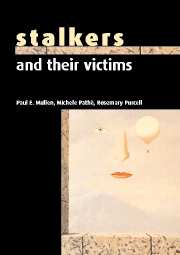Book contents
- Frontmatter
- Contents
- Acknowledgements
- Introduction
- 1 Stalking – a new categorization of human behaviour
- 2 The epidemiology of stalking
- 3 The victims of stalkers
- 4 Classifying stalkers
- 5 The rejected stalker and the resentful stalker
- 6 The predatory stalker
- 7 Intimacy seekers and incompetent suitors
- 8 The erotomanias and the morbid infatuations
- 9 Same gender stalking
- 10 Stalking by proxy
- 11 False victims of stalking
- 12 Stalking and assault
- 13 Reducing the impact of stalking
- 14 Defining and prosecuting the offence of stalking
- 15 Assessing and managing the stalker
- Appendix A Victim services
- Appendix B Important anti-stalking Acts/statutes
- Legal cases and references
- Index
12 - Stalking and assault
Published online by Cambridge University Press: 05 March 2012
- Frontmatter
- Contents
- Acknowledgements
- Introduction
- 1 Stalking – a new categorization of human behaviour
- 2 The epidemiology of stalking
- 3 The victims of stalkers
- 4 Classifying stalkers
- 5 The rejected stalker and the resentful stalker
- 6 The predatory stalker
- 7 Intimacy seekers and incompetent suitors
- 8 The erotomanias and the morbid infatuations
- 9 Same gender stalking
- 10 Stalking by proxy
- 11 False victims of stalking
- 12 Stalking and assault
- 13 Reducing the impact of stalking
- 14 Defining and prosecuting the offence of stalking
- 15 Assessing and managing the stalker
- Appendix A Victim services
- Appendix B Important anti-stalking Acts/statutes
- Legal cases and references
- Index
Summary
Introduction
Stalking emerged as a significant social issue in no small part because it was presented as the harbinger of violent, and potentially homicidal, assault. Arguably the pre-eminent defining instance of stalking was the pursuit of actress Rebecca Schaeffer by a disordered fan who eventually attacked and killed her. This shocking example of the potentially lethal conclusion imminent in stalking was the stimulus to the first anti-stalking legislation (see Chapter 14). In other jurisdictions dramatic examples of stalking behaviours that culminated in serious or fatal physical violence provoked a public outcry that led to the initiating of anti-stalking legislation. In South Australia, for example, the initiative to introduce an anti-stalking Bill related to the killing of a personal assistant to a State Senator. The victim had been stalked by her estranged husband who followed her from one end of Australia to the other. Stalking was constructed initially as a form of threat. This all too easily converted stalking's importance into being not so much bolstered by the potential for violence but reduced to a message the meaning of which was a warning about imminent assault.
Associating stalking with dramatic instances that culminated in dreadful explosions of physical violence propelled stalking into prominence in the media, in the public mind and ultimately onto the legislative agendas of politicians. The advantages of this construction were manifest.
- Type
- Chapter
- Information
- Stalkers and their Victims , pp. 205 - 220Publisher: Cambridge University PressPrint publication year: 2000



